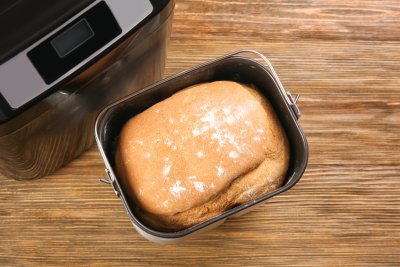Sustain / Real Bread Campaign / Archive
Bread machines

Like any form of home cooking, making a loaf in a bread machine gives you control of the food you eat. You get to choose when and where your Real Bread is made, as well as what goes into it and - importantly - what doesn't.
If you decide you want to wake up to genuinely fresh Real Bread, made from locally stoneground wholemeal flour, water, yeast and a little salt, with no additives, added fat or sugar, a bread maker will do it for you - cheaply and with little effort.
The rise of the machines
The Real Bread Campaign's vision is everyone having the chance to choose Real Bread. On our mission towards this, since 2008 we've advocated buying Real Bread from local, independent bakeries and we continue to do so.
The same goes for encouraging people to roll up their sleeves to mix, knead and shape dough by hand, developing their knowledge and skill to control every stage of the process. It takes very little of your time and many people find the process therapeutic.
For some people, however, a bread machine might be the best solution. For example, at times someone might not:
- have the strength in their hands or wrists to knead.
- have worked out how to fit home baking into their busy life.
- want to turn the oven on for just one loaf.
- have an oven.
Some people who use a machine will stick to it. Others will use it ocasionally, or as a stepping stone towards making bread by hand.
Saving dough
Although food prices increased sharply in 2020, the ingredients for a loaf of Real Bread still cost just pence.
Even if you use the most expensive flour you can find, the price of your Real Bread will rival that of an additive-laden, sliced, supermarket loaf, without any hidden costs that might lurk behind it.
Energy use/cost
When compared to baking in a domestic oven, a bread machine is also a great way to save energy, and therefore reduce carbon emissions.
In 2023, consumer organisation Which? noted: 'If you were to bake two white 1kg loaves every week, under the current energy price cap (28.62p per kWh), it would cost between £7.88 and £12.20 of electricity per year to run your bread maker.'
Back in 2008, Which? calculated the following:
White bread – standard program
Average energy consumption: 0.36 kWh per loaf
Average cycle time: 3 hours 18 minutes
Wholemeal bread – standard program
Average energy consumption: 0.36 kWh per loaf
Average cycle time: 3 hours 54 minutes
By comparison, in 2008 The Energy Saving Trust told the Real Bread Campaign that the energy used in baking a loaf in an electric oven is about 1.6kWh per use and a gas oven typically consumes around 1.5kWh of energy per use.
Pass it on
Rather than suggesting anyone buys a brand new bread machine, we encourage people to dig out an unloved one and use it, or pass it on to someone who will.
According to research carried out in 2023 for independent not-for-profit organisation Recycle Your Electricals, there might be around 1.4 million bread machines going unused in UK homes.
Back in 2010, a study by Mintel reported that 36% of people who received bread machines as presents didn't use them. Older, annual surveys by esure suggested that there might've been up to 10 million of the things gathering dust in cupboards around the UK, next to smoothie makers, foot spas and the like.
Where to give/get a bread machine
Whatever the true, current figures, it seems there are probably plenty to go around. Here are a few ideas of how/where you might get hold or rid of one.
- www.bhf.org.uk
- www.freecycle.org
- www.ilovefreegle.org
- www.olioapp.com
- Local charity that takes and sells electrical goods through its shops / online store.
- Local Facebook group.
- Classified ads in a local newspaper or website.
- Pawn shop.
- Cards in the thwindow of a local shop or Post Office.
- Word of mouth.
Please note
Sustain / the Real Bread Campaign cannot take responsibility for any consequences of you passing on, obtaining or using using a second-hand bread machine.
We strongly recommend that you seek and take the advice of the company/organisation/service you are using regarding electrical safety, stolen goods, personal safety when meeting to give or gain a machine etc.
We also suggest that you only use a machine that has up-to-date PAT (portable applicance testing) certification.
If you have a machine that's faulty/broken that cannot be repaired, your local authority should be able to advise where/how to get it recycled. You can also find a postcode search gizmo on the Recycle Your Electricals website.
See also
- Business Companion's guidance on selling second-hand electrical goods
- Recycle Your Electricals guide to preparing gadgets for sale (some of which may apply to giving them away)
- Electrical Safety First
(On 30 January 2024, we contacted a number of organistions for advice on whether or not the legal responsibilites/liabilities and rights that apply companies and individuals selling and buying second-hand electrical goods also apply if the appliance is given away. Any information we receive we'll publish here)
Recipe
Forget all those bread machine recipes that say you need to use sugar, oil, milk powder, ascorbic acid or whatever - here's Campaign co-founder Andrew Whitley’s recipe for basic Real Bread in a machine
Most bread machine recipes also call for instant or fast acting yeast. Sadly, you you might struggle to find brands that are additive-free and unless you can, your loaves won't be what we cal Real Bread.
Instead, why not try fresh or dried active yeast? For weight conversions click here.
See also
Real Bread Campaign: Finding and sharing ways to make bread better for us, our communities and planet.


